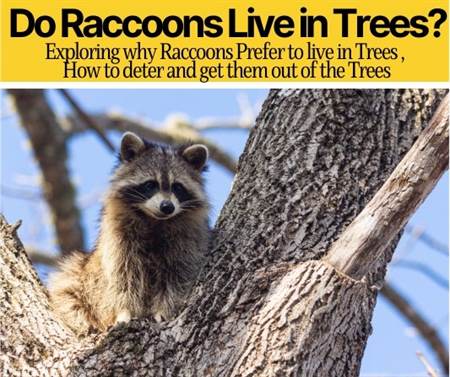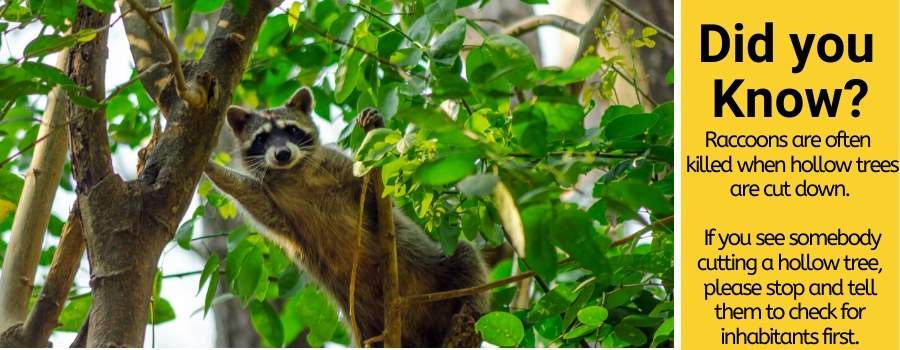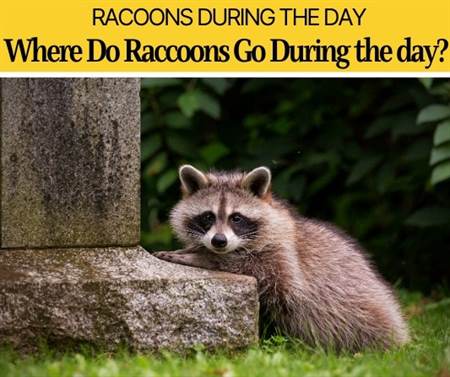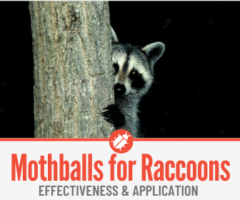 Raccoons are common backyard neighbors around the United States, although they are often considered unwelcome guests.
Raccoons are common backyard neighbors around the United States, although they are often considered unwelcome guests.
Of all the places where raccoons spend their time, they can often be found in trees.
In this Article we will see if they actually live in trees, why do they live in them,
and most importantly how to deter them from climbing and living in tree you might have in your backyard.
Do raccoons live in trees?
Yes, raccoons often live in trees. Raccoons prefer to live in small, dark, and enclosed spaces that will give space to them and their families, but keeps them safe from predators. Trees are Perfect solution for this.They may choose to live in tree trunks or in especially dense foliage that can provide reliable shelter.
Why do raccoons like being in trees and how can we keep them away? This article will explain what motivates raccoons to invade our trees and how to manage unwanted raccoons in the garden.
Can raccoons climb trees? Why do raccoons climb trees?
Raccoons can climb trees well and they do so for a variety of reasons. Raccoons are not able to leap, but racoons are very smart, have excellent claws for climbing, and are able to fall unharmed from significant heights of several feet. Because they cannot jump, raccoons use trees to help them reach other places, such as rooftops.
Trees are also an excellent way of escape from predators and other dangers below. Raccoons can hide among dense foliage or cling to narrow branches beyond reach. They also like invading birds’ nests to steal eggs or eat baby birds.
It is really no wonder that raccoons enjoy climbing trees when it serves so many useful purposes.

Do raccoons nest in trees
Yes, trees are a great place for raccoons to raise their young. Hollow trees with entrances high up the trunk provide a place out of reach of predators that may wish to harm defenseless babies.
Once the young raccoons are of an age to explore, trees also provide opportunities for play and practicing the important skill of climbing. Additionally, trees are an excellent base for young raccoons to return to if they find themselves in danger.
How to stop raccoons from climbing trees
Raccoons need to access the base of a tree in order to climb it. Recommendations to stop this include wrapping various materials around the trunk from where it meets the ground.
One suggestion is to buy a conical tree guard or use 3 feet of sheet metal, which you can read about in this article. Another possible solution is to wrap three lengths of porcupine wire around the base of the trunk in a spiral reaching 9 feet up the tree.
This may seem like a lot, but it can be difficult to deter raccoons from going up trees that are convenient for them to climb. For more ideas about keeping raccoons away, particularly if they have already made a home in the tree, see the section of this article titled What trees raccoons can live in & how to get rid of raccoons in trees.
Do raccoons sleep in trees during the day
Yes raccoons sleep in trees during the day, since it is not uncommon for raccoons to make their homes in trees, this is where they would then spend their sleeping hours. Raccoons normally sleep in the daytime, although they are sometimes active during the day.
See this article to learn where Raccoons Go During the day.
Can raccoons get stuck in trees?
Yes, raccoons can sometimes get stuck in trees, although this may not necessarily be the case if you see a raccoon up a tree. They are generally able to climb up and down on their own without any problem. A raccoon that has climbed out on a narrow limb or high up in the branches may look like it is in trouble even if it is very comfortable, and many raccoon rescue callouts turn out to be unnecessary.
Despite this, it is possible for a raccoon to become stuck in a tree, so it is a good idea to keep an eye on how long a raccoon has been up there. If it has stayed in the same place for more than a day, this may show that it needs help getting down.
Helpful Tips to get Raccoons out of the trees.
Raccoons choose dark, hidden places to live in. Most trees will suit a raccoon looking for a home, as long as the tree has the right kind of trunk or foliage to comfortably shelter the raccoon and its family, if needed.
Raccoons may have a particular preference for old trees due to their hollow trunks, tall ones that offer escape far out of reach, and those with branches that provide access to other places for exploration or to find food. In a moment, we will look at a few examples of the types of trees that raccoons might choose to live in.
First of all, let’s address the difficult question of getting rid of raccoons in trees.
It can be very hard to keep raccoons away, especially if they have already made a home in the tree. We have already seen that raccoons can be deterred from climbing if you wrap sheet metal or porcupine wire around the base of the tree. Here are a few more ideas that are commonly suggested, and why they may or may not work.
Urine
A popular but apparently ineffective solution is to buy coyote urine, or that of other predators to sprinkle around the tree. This does not appear to be very useful, especially when raccoons realize that there are no coyotes in the area.
Trapping
This is another common solution which may work well. It is about transporting the raccoon away from your home to a new area. While trapping may generally be effective, it is also not one hundred per cent successful every time, particularly if the raccoon has babies. A parent will be especially motivated to find its way back to the nest.
Motion-activated devices
Devices like lights and sprinklers can help to convince the raccoon that its home is not such a safe-haven after all. Placing these around the tree will startle the raccoon each time it comes and goes, which usually encourages the raccoon to find a new place to live.
Pepper
Raccoons don’t like spicy substances such as chili. Diluting hot sauce to spray around the area can deter raccoons as they will prefer not to risk contact with their skin.
Removing resources
To begin with, raccoons are likely to set up home in an area that is conveniently situated and close to food sources. Taking these away can force the raccoon to find a more advantageous home.
The tree itself can be made less interesting with the removal of sheltering foliage and any branches that give access to other places. Importantly, as it is food that attracts raccoons to begin with, securing food will make the raccoon look elsewhere.
Common food sources for raccoons include pet food, which can be moved inside the house, and trash, which should be secured in ways that raccoons cannot get into with their paws. If neighbours are willing to help with the same measures, this can drive raccoons out of the immediate area as they search for a home that is near food.
What Trees Raccoons Prefer
Raccoons can be seen in almost any tree,however do they have any personal preferences? Also Let’s see how to deter raccoons from these trees.
Do raccoons live in palm trees
Yes, raccoons sometimes live in palm trees. These can be a popular choice, particularly if the trees have thick frond “skirts” that could conceal raccoons from sight. Raccoons may be kept out of palm trees by wrapping the base, trapping, using pepper or motion-activated devices or removing resources.
Cutting away the frond skirt may be a possibility, although it will change the look of the tree quite dramatically.
Do raccoons live in pine trees
Yes, raccoons may be found living in pine trees. These trees are favored for their height and large trunks that may contain tree hollows. As well as the other methods for deterring raccoons, it may be helpful to cut back any branches that raccoons can use to get to other places.
Do raccoons live in fruit trees & How to keep them out of fruit trees
Raccoons love eating sweet fruit, although they will only live in trees with sturdy structures that can shelter them. Whether they live in the tree or only stop by to eat the fruit, raccoons can be a nuisance for fruit-growers.
Besides the recommendations we have already seen to stop raccoons from climbing trees, it is also important to make sure the raccoon on the ground cannot reach fruit growing on low-hanging branches. Branches should be removed from within three feet of the ground. After this, it is recommended to add a sheet metal collar to the base and trunk of the tree.
Do raccoons live in tree holes
Yes, raccoons can often be found in tree holes and hollow trees. They like any place where they can hide and feel secure and enclosed. Raccoons are only likely to settle into a tree hole if they have food sources nearby. Besides trees, they also make their dens in many other places, such as in attics, under fallen logs and in dense brush.
Read more: Animals that Dig Holes in Yard
Do raccoons sleep in the same place every night?
Raccoons are territorial, and they will select a place to make a semi-permanent den that they return to when it’s time to sleep. If the place becomes unsuitable, raccoons may abandon their old den to make a new home elsewhere.
However, it is worth noting that raccoons don’t usually sleep at night. Raccoons are nocturnal, which means they are active at night and sleep during the day. In the daytime, raccoons will retire to their established dens to sleep before coming out at night to search for food.
Understanding raccoon behavior is an important step in preventing them from becoming too comfortable in your garden. Raccoons are persistent and clever, so it can be a challenge to keep them out of trees. There are several strategies that may prove successful, and a combination of these solutions can help keep your trees raccoon-free.






